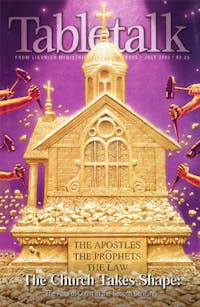
Request your free, three-month trial to Tabletalk magazine. You’ll receive the print issue monthly and gain immediate digital access to decades of archives. This trial is risk-free. No credit card required.
Try Tabletalk NowAlready receive Tabletalk magazine every month?
Verify your email address to gain unlimited access.
The second century after the death and resurrection of our Lord (A.D.) was not, despite some modern bleats to the contrary, the second century of the common era (C.E.). During the course of the second century, the ancient dating system had not yet been changed, but all the realities had been altered. The yeast of the kingdom was in the loaf of the world, and nothing could stop what was to happen. Twenty centuries later, those same pagan realities remain undone forever, however much our modern and enlightened academics play with the dating system in their journal articles, tee-heeing as they tend to do.
In the second century, the Christian church had not yet overthrown the existing pagan system. And yet the confidence of these Christians was astounding. They knew that something had happened in the previous century that had altered human history. It had not been that long ago; it was still vivid for them. Even in the middle of the century, A.D. 150, there were men and women who remembered the way the apostle John used to teach them. They remembered the stories he used to tell them about the way the Lord Jesus used to live, and how He taught. But above all else, they remembered John’s testimony about the hard run he took one morning to an empty tomb. The grave-clothes had been there, but nothing else. John then walked outside with Peter and into a world made new. It took some time for that world to realize it, but nothing was ever the same.
By the next century, the novelty of the new creation had not yet worn off in the minds of Christians. To put this in perspective, at the beginning of the second century, the resurrection of the Lord had the same kind of historical relationship to them (in terms of elapsed time) as the election of Franklin D. Roosevelt has to us. Pontius Pilate was still a regional governor in living memory, like Huey Long, and not a detached historical name floating around in books.
But the reason we have lost this perspective is not the mere result of time passing. Our problem is caused by our accommodation of Enlightenment biases, which are simply a revived form of Gnosticism—the great foe of the church in the second century. In other words, the ancient Christians were fiercely defending certain historical realities against those who wanted a religion of timeless religious propositions, principles, and truths. The Christian faith taught that Ultimate Truth had a face and two hands, and used to work in a carpentry shop. If telephones had been invented back then, His name would have been in the phone book under the Ds—Davidson.
Gnosticism held that there was a sharp divide between the spiritual and material, and that the spiritual was pure and ethereal while the material was corrupt and gross. If, however, the material world was all that bad, how was it possible that anybody down here in the middle of it, like Gnostics for instance, had any accurate idea of what was going on? The Gnostic answer was that a certain privileged few had a divine spark within them, a secret gnosis, or knowledge, that clued them in.
Now one of the reasons why so much of the Christian world today is spiritually moribund is that we have quit fighting the contemporary Enlightenment forms of Gnosticism. The pure spiritual realm is made up of the abstract propositions in our statements of faith, and we know these are true because of that gnosis in our hearts, which we now like to call a personal relationship with Jesus.
In saying this, it is important to immediately explain what I do not mean. I do not intend any form of unbelief in the creedal propositions rightly understood. Rather, I am objecting to unbelief in the propositions, one that is accomplished by a very subtle sleight of mind. Jesus said that the Jewish leaders searched the Scriptures—because they thought they would find life. But those Scriptures, Jesus said, bore witness to Him. Propositional truth, whether found in the book of Romans or in the Westminster Confession of Faith, must be understood as a window through which we look. Every true statement, rightly handled, is a window through which a man may see. But every true statement also can become a mural, at which a very “conservative” man can blindly stare. And if anyone points out that the objects in the mural are alive, he brings that person up on charges.
And, of course, there is such a thing as a true relationship with Jesus Christ—He is the Bridegroom, and we are covenantally His bride. God will be our God, and we will be His people. But this relationship is far more glorious than a Gnostic spark hidden away in the recesses of a man’s heart.
The Christians of the second century knew by faith that all these things had happened just yesterday. Our task is to believe in the same way—because Jesus Christ is the same, yesterday, today, and forever.
